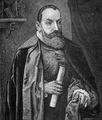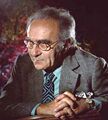Template:Selected anniversaries/August 22: Difference between revisions
Jump to navigation
Jump to search
No edit summary |
No edit summary |
||
| (7 intermediate revisions by the same user not shown) | |||
| Line 2: | Line 2: | ||
||1572: Rudolph Goclenius the Younger born ... physician and professor of physics, medicine and mathematics at the Philipps University of Marburg. He was the oldest son of Rudolph Goclenius, who was also professor of rhetoric, logic and ethics at Marburg. As a physician he worked on cures against the plague. He became famous for his miraculous cure with the "weapon salve" or Powder of Sympathy. Based on the hermetic concepts of Paracelsus he published 1608 the proposition of a "magnetic" cure to heal wounds: the application of the salve on the weapon should heal the wounds afflicted by the weapon. This concept was brought to England by the alchemist Robert Fludd. A famous proponent was Sir Kenelm Digby. Synchronising the effects of the powder (which apparently caused a noticeable effect on the patient when applied) was actually suggested in the leaflet Curious Enquiries in 1687 as a means of solving the longitude problem. Pic. | ||1572: Rudolph Goclenius the Younger born ... physician and professor of physics, medicine and mathematics at the Philipps University of Marburg. He was the oldest son of Rudolph Goclenius, who was also professor of rhetoric, logic and ethics at Marburg. As a physician he worked on cures against the plague. He became famous for his miraculous cure with the "weapon salve" or Powder of Sympathy. Based on the hermetic concepts of Paracelsus he published 1608 the proposition of a "magnetic" cure to heal wounds: the application of the salve on the weapon should heal the wounds afflicted by the weapon. This concept was brought to England by the alchemist Robert Fludd. A famous proponent was Sir Kenelm Digby. Synchronising the effects of the powder (which apparently caused a noticeable effect on the patient when applied) was actually suggested in the leaflet Curious Enquiries in 1687 as a means of solving the longitude problem. Pic. | ||
File:Denis Papin.jpg|link=Denis Papin (nonfiction)|1647: Physicist, mathematician, and inventor [[Denis Papin (nonfiction)|Denis Papin]] born. | File:Denis Papin.jpg|link=Denis Papin (nonfiction)|1647: Physicist, mathematician, and inventor [[Denis Papin (nonfiction)|Denis Papin]] born. Papin will invent the steam digester, the forerunner of the pressure cooker and the steam engine. | ||
||1664: Maria Cunitz dies ... astronomer, and one of the most notable female astronomers of the modern era. She authored a book ''Urania propitia'', in which she provided new tables, new ephemera, and a more elegant solution to Kepler's problem. Pic. | ||1664: Maria Cunitz dies ... astronomer, and one of the most notable female astronomers of the modern era. She authored a book ''Urania propitia'', in which she provided new tables, new ephemera, and a more elegant solution to Kepler's problem. Pic. | ||
| Line 8: | Line 8: | ||
||1751: Andrew Gordon dies ... Benedictine monk, physicist and inventor. He made the first electric motor. Pic: https://www.beatson.co.uk/history-electric-motors/ | ||1751: Andrew Gordon dies ... Benedictine monk, physicist and inventor. He made the first electric motor. Pic: https://www.beatson.co.uk/history-electric-motors/ | ||
||1752: William Whiston dies ... mathematician, historian, and theologian. | ||1752: William Whiston dies ... mathematician, historian, and theologian. Pic. | ||
||1771: Henry Maudslay born ... engineer. | ||1771: Henry Maudslay born ... engineer. Pic. | ||
||1787: Inventor John Fitch demonstrated his steamboat on the Delaware River to delegates of the Continental Congress. Its top speed was 3 mph. These tests were completed years before Fulton built his steamboat. Early in 1787, the Colombian Magazine described the steam engine design as “similar to the late improved steam engines in Europe,” with a horizontal twelve-inch cylinder. The piston was proposed to give “thirty strokes in a minute; which will give the axle tree about forty revolutions. Each revolution of the axle tree moves twelve oars five and a half feet. As six oars come out of the water, six more enter the water... The oars work perpendicularly and make a stroke similar to the paddle of a canoe.” | ||1787: Inventor John Fitch demonstrated his steamboat on the Delaware River to delegates of the Continental Congress. Its top speed was 3 mph. These tests were completed years before Fulton built his steamboat. Early in 1787, the Colombian Magazine described the steam engine design as “similar to the late improved steam engines in Europe,” with a horizontal twelve-inch cylinder. The piston was proposed to give “thirty strokes in a minute; which will give the axle tree about forty revolutions. Each revolution of the axle tree moves twelve oars five and a half feet. As six oars come out of the water, six more enter the water... The oars work perpendicularly and make a stroke similar to the paddle of a canoe.” | ||
| Line 36: | Line 36: | ||
||1873: Alexander Bogdanov born ... physician and philosopher. Pic. | ||1873: Alexander Bogdanov born ... physician and philosopher. Pic. | ||
||1985: Paul Peter Ewald dies ... physicist and crystallographer whose theory of X-ray interference by crystals was the first detailed, rigorous theoretical explanation of the diffraction effects first observed in 1912 by his fellow physicist Max von Laue. Pic | ||1985: Paul Peter Ewald dies ... physicist and crystallographer whose theory of X-ray interference by crystals was the first detailed, rigorous theoretical explanation of the diffraction effects first observed in 1912 by his fellow physicist Max von Laue. Pic search. | ||
||1907: Abraham | ||1907: Abraham Sinkov born ... cryptanalyst. Pic. | ||
||1913: Bruno Pontecorvo born ... physicist and academic. | ||1913: Bruno Pontecorvo born ... physicist and academic. Pic. | ||
||1915: James Hillier born ... scientist, co-designed the electron microscope. | ||1915: James Hillier born ... scientist, co-designed the electron microscope. Pic. | ||
||1918: Korbinian Brodmann dies ... neurologist and academic. | ||1918: Korbinian Brodmann dies ... neurologist and academic. | ||
File: | File:Ray Bradbury 1959.jpg|link=Ray Bradbury (nonfiction)|1920: Science fiction writer and screenwriter [[Ray Bradbury (nonfiction)|Ray Bradbury]] born. ''The New York Times'' will call Bradbury "the writer most responsible for bringing modern science fiction into the literary mainstream". | ||
||1920: Surgeon Denton Arthur Cooley born. Cooley will perform the first implantation of a total artificial heart. Pic. | |||
||1921: Bernard d'Espagnat born ... theoretical physicist, philosopher of science, and author, best known for his work on the nature of reality. Pic | ||1921: Bernard d'Espagnat born ... theoretical physicist, philosopher of science, and author, best known for his work on the nature of reality. Pic search. | ||
||1923: Hidehiko Yamabe born ... mathematician. Famous for discovering that every conformal class on a smooth compact manifold is represented by a Riemannian metric of constant scalar curvature. Pic search | ||1923: Hidehiko Yamabe born ... mathematician. Famous for discovering that every conformal class on a smooth compact manifold is represented by a Riemannian metric of constant scalar curvature. Pic search. | ||
||1926: Charles William Eliot dies ... mathematician and academic. Selected as Harvard's president in 1869, Eliot transformed the provincial college into the pre-eminent American research university. Pic. | ||1926: Charles William Eliot dies ... mathematician and academic. Selected as Harvard's president in 1869, Eliot transformed the provincial college into the pre-eminent American research university. Pic. | ||
| Line 59: | Line 59: | ||
||1932: The first experimental television program broadcast from the BBC, London. | ||1932: The first experimental television program broadcast from the BBC, London. | ||
||1933: Alexandros Kontoulis dies ... Greek general and diplomat. | ||1933: Alexandros Kontoulis dies ... Greek general and diplomat. | ||
| Line 66: | Line 64: | ||
||1939: The first U.S. patent for dispensing liquids under pressure from a disposable container was issued to Julius Seth Kahn of New York City (No. 2,170,531). The patent was titled "Apparatus For Mixing a Liquid With a Gas," but was the predecessor of the aerosol spray can. In this case, the patent more particularly specified a use for whipping cream "by discharging the cream and gas mixture through a constricted orifice." The cream could be contained in a common soda-pop glass bottle. Gas could be introduced at controlled pressure. An inexpensive valve discharged the whipped cream. Its use was extended to applications such as dispensing paints, pharmaceuticals and insecticides. | ||1939: The first U.S. patent for dispensing liquids under pressure from a disposable container was issued to Julius Seth Kahn of New York City (No. 2,170,531). The patent was titled "Apparatus For Mixing a Liquid With a Gas," but was the predecessor of the aerosol spray can. In this case, the patent more particularly specified a use for whipping cream "by discharging the cream and gas mixture through a constricted orifice." The cream could be contained in a common soda-pop glass bottle. Gas could be introduced at controlled pressure. An inexpensive valve discharged the whipped cream. Its use was extended to applications such as dispensing paints, pharmaceuticals and insecticides. | ||
||1940: Oliver Lodge dies ... physicist and academic. | ||1940: Oliver Lodge dies ... physicist and academic. Pic. | ||
||1941: Plasma physicist and academic Hannspeter Winter born. He will research hollow atoms. Pic search | ||1941: Plasma physicist and academic Hannspeter Winter born. He will research hollow atoms. Pic search. | ||
||1945: Ida Henrietta Hyde dies ... physiologist known for developing a micro-electrode powerful enough to stimulate tissue chemically or electronically, yet small enough to inject or remove tissue from a cell. Pic. | ||1945: Ida Henrietta Hyde dies ... physiologist known for developing a micro-electrode powerful enough to stimulate tissue chemically or electronically, yet small enough to inject or remove tissue from a cell. Pic. | ||
| Line 86: | Line 84: | ||
File:Jacob Bronowski.jpg|link=Jacob Bronowski (nonfiction)|1974: Mathematician, historian of science, theatre author, poet, and inventor [[Jacob Bronowski (nonfiction)|Jacob Bronowski]] dies. | File:Jacob Bronowski.jpg|link=Jacob Bronowski (nonfiction)|1974: Mathematician, historian of science, theatre author, poet, and inventor [[Jacob Bronowski (nonfiction)|Jacob Bronowski]] dies. | ||
||1975: Andrzej Mostowski dies ... mathematician. He is perhaps best remembered for the Mostowski collapse lemma. | ||1975: Andrzej Mostowski dies ... mathematician. He is perhaps best remembered for the Mostowski collapse lemma. Pic (math). | ||
||1977: Karl Walter Schröter dies ... mathematician and logician. Later on, after the war, he made important contributions concerning semantic consequences (German: semantische Folgerungsrelationen) and provability logic (German: syntaktische Ableitbarkeitsrelationen). He worked as a mathematical theoretician and cryptanalyst for the civilian Pers Z S, the cipher bureau of the Foreign Officeduring World War II. Pic. | ||1977: Karl Walter Schröter dies ... mathematician and logician. Later on, after the war, he made important contributions concerning semantic consequences (German: semantische Folgerungsrelationen) and provability logic (German: syntaktische Ableitbarkeitsrelationen). He worked as a mathematical theoretician and cryptanalyst for the civilian Pers Z S, the cipher bureau of the Foreign Officeduring World War II. Pic. | ||
Latest revision as of 13:15, 7 February 2022
1647: Physicist, mathematician, and inventor Denis Papin born. Papin will invent the steam digester, the forerunner of the pressure cooker and the steam engine.
1854: Poet Jan Kochanowski dies. He established poetic patterns which would become integral to the Polish literary language.
1920: Science fiction writer and screenwriter Ray Bradbury born. The New York Times will call Bradbury "the writer most responsible for bringing modern science fiction into the literary mainstream".
1974: Mathematician, historian of science, theatre author, poet, and inventor Jacob Bronowski dies.



